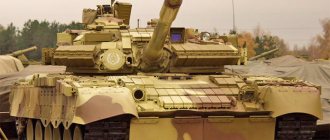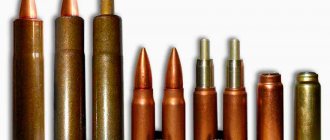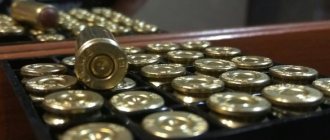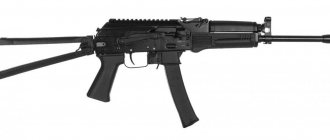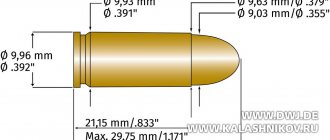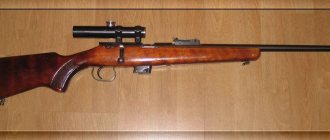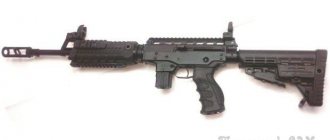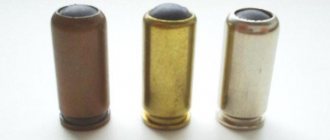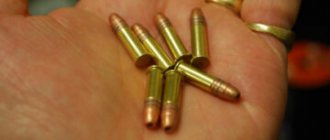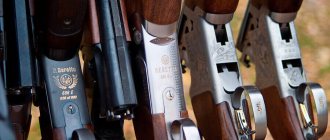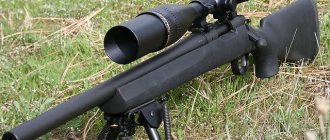To date, there is not a single action movie in which there would not be a shootout between the main character and the bad guys. For greater realism, weapons that fire blank cartridges are often used. At such moments, the expression “shoot blank” immediately comes to mind. It usually means wasted time and money. But the film business is the very case when this saying works exactly the opposite. But such cartridges were not developed for the amusement of the public, but for war.
How does a blank cartridge work?
First of all, it is necessary to understand the principle of operation of a live cartridge. After pressing the trigger, the mainspring is released, and under the action of the spring the trigger rushes towards the firing pin. Under the impact of the trigger, the firing pin pierces the cartridge's primer, and a mini-explosion occurs, leading to the ignition of the cartridge's powder charge. Under the influence of the energy of the powder gas, the bullet flies out of the barrel, and the gas itself is dissipated through the muzzle brake-compensator.
A blank cartridge works approximately the same way. The only difference is that the bullet does not fly out. It’s simply not in the cartridge. Instead, it is most often imitation wood or plastic. Quite often there are variants with the edges flattened in place of the bullet. Everyone probably remembers cartridges with an “asterisk” at the end? The latter option is considered uneconomical, since the sleeve is irreparably damaged.
Accident
The phrase “firing blanks” has long been in common use, but what does it literally mean? What are blank cartridges and why are they capable of causing not only serious injury, but also killing a person? Let's figure it out.
Each of us has heard about blank cartridges at least once, and most people rightly believe that blanks are dummies that only create the visual and sound effect of shooting. To some extent, this is true; blank cartridges are used in a variety of situations, from sports to cinema and even theater. And if you have at least once seen a blank cartridge, then it is quite understandable to be surprised that it could be the cause of death - there is no bullet there! However, if a gun with a blank cartridge is pointed at a person's head or chest, the shot can be fatal. Moreover, such cases occur regularly, although not en masse.
To understand what a blank cartridge is, just look at the diagram of a typical ammunition device.
To work correctly, the cartridge and weapon must include elements that trigger the firing process - they ignite the “fuel”, generating a lot of gas that pushes the projectile (bullet) out of the barrel and towards the target.
Once upon a time, cartridges came in packages where each component was kept separately. Shooters had to load them into the barrel one at a time before pulling the trigger. This process was slow, so over time, muskets gave way to traditional cartridges, which already included everything necessary for shooting.
Modern cartridges consist of four main elements:
- Projectile (bullet)
- Sleeve
- Gunpowder (fuel)
- Primer-igniter
Without a bullet, the cartridge will be ineffective in most cases, since nothing will happen besides the pop and the release of gas, since it is the projectile that penetrates the target at a distance.
To maximize damage, the bullet is usually made of a heavy, dense material, most often lead, although specialized projectiles are also available. The projectile accelerates to high speed, so it can even penetrate a person, depending on where it hits. Blank cartridges use a piece of paper or other relatively safe material instead of a bullet, the weight, density and speed of which make it safe at distances greater than 50 centimeters. Unless the shooter was aiming straight at the eye.
Tragedies occur when people point guns loaded with blanks at themselves or others and pull the trigger. Especially in the entertainment industry where blanks with extra powder are sometimes used to create a nice flash. In addition, the edges of the blanks can be folded inward to make the paper sit tighter, increasing the internal gas pressure. As a result, a large volume of gas leaves the barrel and quickly loses energy, spreading in different directions. But upon close contact, the concentrated gas is more like a hammer blow, capable of crushing bone.
Accidents involving the use of idle do not occur often, but they leave a deep mark. Recently, on the set of the film Rust, actor Alec Baldwin used a "set" gun, thinking it was not loaded. It turned out that there was a cartridge - as a result, the cameraman died and the director was injured.
Five famous tragedies on the set
Real weapons are not toys. Even if it's used on set and loaded with blanks, a gun is a killing tool. If you treat it irresponsibly, then in most cases the consequences are tragic.
Illustration: Linus Scheffel
Military use of blank cartridges
Soviet GP-25 “Koster” grenade launcher
After firing a blank cartridge, the same powder gases are formed as after a live shot. However, due to the absence of a warhead, all energy is wasted. However, during the First World War, blank cartridges found an unexpected use: they were used to launch hand grenades. A special structure was attached to the barrel of the rifle, into which the charge was placed. A shot is fired from the gun in the direction of the enemy, and the grenade, under the influence of the energy of the shot, flies into the enemy trenches. The flight range significantly exceeded the distance of a manual throw. However, already in World War II the technology was developed into portable mortars.
In addition, such a launch of grenades gave rise to the development of under-barrel grenade launchers. For example, the Soviet GP-25 Koster grenade launcher works according to the same scheme. At the same time, Kalashnikov had long planned to use the experience of the First World War instead of an under-barrel grenade launcher. This technology was abandoned, and the choice fell in favor of a more efficient GP. In the West they also experimented with launching grenades by shooting a blank cartridge.
A daily boost of fighting spirit!WARHEAD.SU
It seems that almost everyone knows what a “dry-firing attachment” is. This is a bushing screwed onto the muzzle of a weapon with a small diameter hole in the front. If we are talking about Russia and AKMoids, then special blank cartridges are used in the kit with the nozzle - now this is 5.45x39 mm "7X3" ammunition with a white plastic bullet.
When passing through the nozzle, the bullet is destroyed, its small fragments are relatively safe (but only “comparatively” - it’s not worth shooting at the “enemy” from a distance of less than five meters). Such shooting from the outside looks very impressive, but during army exercises, the effect of using blanks was completely “not the same.” Assessing the effectiveness of a military unit's fire has always required the assistance of third-party intermediaries who will sit in on the exercise and determine who survived, who is wounded, and who is killed based on their evaluation criteria.
It was not possible to determine the individual marksmanship of an individual soldier in this way; everything was very ephemeral. The company shot well at the shooting range, which means they won’t let you down in battle. And this, as we know, is not always true.
The military was very concerned about this issue, but they took it seriously only with the widespread “commissioning” of lasers - more precisely, their lightweight and not too energy-consuming models.
In the early 80s of the last century, the American company Simulaser developed a system called MILES (Multiple integrated laser engagement system). To use it, laser radiation receivers were placed on the soldier’s uniform, and the laser emitter itself was attached to his personal weapon. Firing was carried out with blank cartridges; a special plug was placed on the muzzle of the barrel, which prevented the possibility of firing conventional ammunition. With each shot, the laser sent a short pulse towards the target, and if the beam hit one of the sensors, the system gave a sound signal (a loud and rather nasty squeak). In addition, the sensors were placed on military equipment: they were programmed so that, for example, a soldier with an assault rifle could not “knock out” a gun or tank.
At first, MILES was not perfect: soldiers complained that the helmet with such a body kit was excessively heavy. In addition, especially harmful servicemen, even after they were “conditionally killed,” did not want to meekly wait for the end of the battle and continued to fire at the enemy.
Everything is like in childhood: “Pew-pew, you’re killed!” - “It’s not fair, you’ve already been killed!” - “And I’m doing my best!!!”
Over time, these shortcomings were corrected: now, when hit, the system blocks the shooter’s weapon. MILES-2000 has now become a standard not only in NATO, but also in many other countries around the world.
Anton Zheleznyak Technical and engineering expert
You can say: “Excuse me, this is laser tag!” - and you will be absolutely right. The kit for this game (and the later "firetag") is a simplified "civilian" version of MILES
The Chinese army (let me remind you, the largest in the world) was also interested in such an imitation device and made its own version. However, the squeaking of MILES was not enough for the Chinese: in the cannonade of the battlefield, you can figure out who is squeaking and where. Therefore, they placed not only laser radiation receivers on the soldiers’ helmets, but also small smoke bombs that were triggered when they conditionally hit the wearer.
Opposing units have different smoke colors, so an observer-intermediary can immediately distinguish which of the combatants has been “killed.” True, a large number of detonated pyrotechnic charges causes a fair amount of smoke on the battlefield, but the Chinese put up with this (apparently, the national love for pyrotechnics affects it).
In the USSR, the first imitation laser system adopted for service was the 9F824 “Fearlessness” - this happened in 1986, but it did not become widespread (“the times were difficult”).
At the end of the 90s, it was replaced by the 9F838 Tselik complex - with some modifications it is still produced. The kit, in particular, includes two types of IP (defeat simulators) and a dozen types of IS (shooting simulators), which can be installed on any weapon in service with the Russian army - from Kalashnikov assault rifles to grenade launchers and ATGMs.
By the way, our manufacturers were also not satisfied with “squeakers”: to indicate defeat, a fabric cover with flip flaps is put on a soldier’s helmet: on the outside they are camouflage-colored, on the inside they are bright red. When a hit is detected, the valve turns to the bright side: it is not as noticeable as the smoke plume of the Chinese, but it does not interfere with the remaining “lives” from fighting.
True, in modern times the weight and dimensions of the 9F838 are still too large - even taking into account the innate love of the military for the indestructibility and quality of equipment. We hope that in the near future the Russian armed forces will receive something newer and more compact.
Why can't you shoot with a pneumatic gun blank?
The operating principle of a conventional air rifle is similar to the blowguns that were used in Asia. The first such weapon was created in 1430 in Germany by Hutter. It worked based on the principles of compression and its only purpose was to kill animals during the hunt.
The principle of this functioning became interesting to many gunsmiths, and they began to learn from experience, trying to improve it. Therefore, after a century and a half, a new model was presented to the royal court, this time created by the gunsmith Marel. A whole era of pneumatics opened, and it became quite popular among rich people. Another two hundred years later, the history of pneumatics was enriched with new inventions: the double-barreled shotgun - the first barrel that fired gunpowder, and the second using pneumatics. The second invention was a rifle that could shoot several times in a row.
Then, in addition to the function of hunting, rifles began to perform the function of real military weapons. The first weapons factories for weapons powered by pneumatics appeared.
And the real discovery of the world of pneumatics was the nineteenth century, when it became fashionable. Clubs and tournaments using air guns begin. Such weapons become available to a wide range of people, not only to aristocrats and noble rich people.
Why can't you shoot with a pneumatic gun blank? Safety precautions for handling an air rifle
- Handle it as you would any other weapon with care.
- Before use, please read the instructions.
- Even if it is idle, handle it as if it is charged and remember the saying. That once a year the stick shoots.
- You shouldn’t point it at people, even just an empty one. The same should happen with animals. Remember that a bullet can fly three hundred meters, and even more. Therefore, make sure that no one is in the affected area.
- Do not keep your fingers on the trigger to avoid accidentally firing.
- Do not take ammunition from other weapons, only those intended for this model.
- Shooting from pneumatics should take place in specially designated areas.
- Do not carry a loaded rifle, as this may cause an accident. It is imperative to charge only before firing a shot.
- Do not shoot at water or very hard surfaces; the fired bullet may ricochet and hit the shooter or people nearby.
- If you take a weapon from someone, be sure that it is not loaded. Check it further. The same applies to the transfer of weapons; it must be done only unloaded.
- Air pistols are carried only in a holster, and rifles are put away in a case. Storage is carried out in special places, away from children and cartridges. Only people who are over 18 years old are given weapons.
- You cannot fire a rifle dry. Why can't you shoot with a pneumatic gun blank? In this case, the energy of the spring is transferred not to the bullet, but to the cuff. The weapon deteriorates, the stock may even crack, and the power of the rifle decreases.
Device for firing blank cartridges from a Kalashnikov machine gun (PK)
89. A device for firing blank cartridges from a Kalashnikov machine gun () consists of a bushing and a guide bar for the base of the receiver (Fig. 82).
Rice. 82. Device for firing blank cartridges from a Kalashnikov machine gun (PK):
a - bushing; b - guide bar; 1 - short feathers; 2 - long feathers with protrusions; 3 - jumper with a persistent protrusion
The design of the bushing is the same as the bushing for firing blank cartridges from a Kalashnikov assault rifle and light machine gun.
The guide plate of the receiver base serves to guide the blank cartridge into the barrel chamber and has two short and two long feathers with projections and a bridge with a thrust projection.
To prepare the machine gun for firing blank cartridges, it is necessary to unscrew the flash suppressor and screw on the bushing. Then you need to attach the guide bar of the receiver base, to do this, open the receiver cover; raise the receiver base; move the bolt frame behind the reloading handle until it is cocked; Holding the base of the receiver in a vertical position with your left hand, with your right hand take the guide bar by the stop protrusion with the short feathers down and insert it with the long feathers into the recesses of the base of the receiver so that the protrusions of the feathers lie on the walls of the receiver window, insert the bar into the slot in the walls of the receiving window and feed it up all the way; lower the base of the receiver and lower the bolt carrier from cocking, holding it by the reloading handle.
